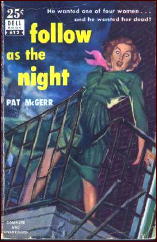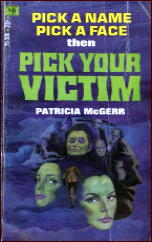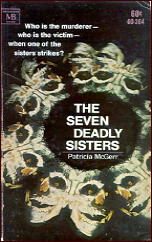Sat 8 Dec 2012
Archived Review: PATRICIA McGERR – …Follow, As the Night…
Posted by Steve under Authors , Bibliographies, Lists & Checklists , Reviews[8] Comments
PATRICIA McGERR – …Follow, As the Night… Macfadden, paperback reprint, 1968. Previously: Dell #612, paperback, 1952. First published by Doubleday Crime Club, hardcover, 1950.

Patricia McGerr seems to have a split career as a mystery writer, and if I’m wrong on some of these titles and in which category they fall, perhaps somebody reading this can quickly steer me in the right direction.
Here’s a list of the titles of the first eight books she did, all for Doubleday’s noted Crime Club series:
The Seven Deadly Sisters, 1947.
Catch Me If You Can, 1948.
Save the Witness, 1949.
Follow, As the Night, 1950.
Death in a Million Living Rooms, 1951.
Fatal in My Fashion, 1954.
After a gap of about ten years, the following grouping came along, with the last three published in hardcover by Robert B. Luce, Inc., a firm about which I know nothing, except that its primary mystery output was by McGerr.
Murder Is Absurd, 1967.
Stranger with My Face, 1968.
For Richer, for Poorer, Till Death, 1969.
Legacy of Danger (collection of short stories fixed up as a novel) 1970. [Selena Mead]
And then the last grouping consists of two paperback originals:
Dangerous Landing, Dell, 1975.

To take the last two first, this is a guess, but from the titles they appear to be very much akin to the ubiquitous gothic novels which were very popular at the time.
Working backward, the middle grouping might be characterized by the Selena Mead counterespionage novels, which two of them are. Someone else will have to say for sure what the other three are — spy thrillers, malice domestic, or a mixture of each, called romantic suspense?
Most of McGerr’s fame today, of which there is not nearly enough, resides in the first grouping, which include some of the strangest and possibly unique detective novels ever written.
I’ve read Pick Your Victim, and it’s not one I’ll easily forget. We know there has been a murder done, who has committed it, and from only scraps of evidence is the identity of the victim eventually deciphered. A summary I’ve found of The Seven Deadly Sisters suggests that McGerr upped the puzzle twofold: neither the killer nor the victim is known, and the identities of both have to be worked out.
…Follow, As the Night… (complete with double ellipses, at least in the paperback version) is very much in the same category. In a brief prologue, we learn someone has died, and in Chapter One, we find the killer (identity known) planning a dinner party, with one of those invited being the person he intends to become the victim of a fatal accident.

Invited are Larry Rock’s two ex-wives (one not yet divorced), his mistress, and his current fiancée, who is also — as if this were not enough — pregnant. It makes for quite an evening. In fact that’s all the time it takes for the events of the entire book to transpire; that is, if flashbacks don’t count.
The detective per se is Rock’s first wife, who arrives early and finds the loose railing on the penthouse balcony. Knowing exactly what he intends to do, her problem, identify the victim — which may be her!
The bulk of the book is a character study, then, of a cad, a word that I don’t use very often, but it certainly fits both the period (the late 1940s) and the man. Problem: I knew how the book was going to come out as of page 10, and while there was a good chance that I was wrong, I wasn’t.
The gimmick didn’t work, in other words, or not for me, but the character study did. It’s not enough for an unqualified recommendation, but from the perspective of a clever approach to a detective novel, it’s certainly worth reading.
December 9th, 2012 at 12:25 pm
My good friend and ace researcher Victor Berch has sent me some information on Patricia McGerr, which I’ve excerpted from CONTEMPORARY AUTHORS:
Patricia McGerr, American Novelist (1917 – 1985). Construction Methods magazine, New York, NY, assistant editor, 1943-48; freelance writer, 1948-85. Lecturer and consultant, Georgetown University Writers’ Conference, beginning 1960. Mystery Writers of America (member of board of directors, 1959-62, 1965-69, 1977-81).
And from this publisher’s online obituary:
Robert B. Luce, 83, publisher of the New Republic magazine in the 1960s, died Nov. 29 at a nursing home in Boca Raton, Fla.
Luce became publisher of the New Republic, an influential public affairs magazine, in 1963, after earlier publishing Changing Times magazine.
He founded the Washington, D.C.-based publishing house Robert B. Luce Inc. in the 1960s. The firm’s first book, “The Kennedy Circle,” was published just before John F. Kennedy’s 1961 inauguration as president.
December 9th, 2012 at 12:27 pm
Some additional info on McGerr can be found on the Golden Age of Detection wiki:
http://gadetection.pbworks.com/w/page/7931041/McGerr,%20Pat
December 9th, 2012 at 6:15 pm
Steve,
I’ve read and liked some of the Selena Mead short stories. They have clever plots. And the basic set-up anticipates the TV show SCARECROW AND MRS KING, with a housewife helping professional US spies.
But I was underwhelmed by the much praised PICK YOUR VICTIM. It does have a unique gimmick. But the story, characters and setting all seemed uninteresting. It’s a satire on a Washington foundation bureaucracy, and everyone seems dull.
December 9th, 2012 at 6:37 pm
I have a feeling you’re right about PICK YOUR VICTIM, Mike. I read it quite a while ago, and all I remember about it is the gimmick.
Based on my review of FOLLOW AS THE NIGHT, though, I seem to have liked the character study it provided more than I did the cleverness of the plot. (Either that or I based my dismissal of it on the fact that I figured it out too soon.)
December 9th, 2012 at 7:03 pm
More McGerr books are available in Michigan libraries, including the Selena Mead books. Your review suggests I should check them out!
December 12th, 2012 at 11:13 am
I couldn’t finish PICK YOUR VICTIM. I side with Mike – dull characters, flat writing.
December 12th, 2012 at 11:31 am
John
Fair enough. That’s usually the case in detective stories in which the puzzle’s the thing, and the only thing. On the other side of the coin, I did some searching and I found a much more favorable review of PICK YOUR VICTIM online, and of all places, on my own blog:
https://mysteryfile.com/blog/?p=5782
Marv Lachman said, in part:
“Not content to rely upon an original idea, she followed through, though this was only her first book, to create a mystery that was worthy of its conception. It is small wonder that Barzun and Taylor, who labeled this book a “whodunin,†also called it a masterpiece.”
On his blog, TomCat said:
http://moonlight-detective.blogspot.com/2011/02/pick-your-victim-1946-detective-story.html
“Pat McGerr’s Pick Your Victim is a comparatively little-known entry into the annals of crime fiction, but which is nevertheless held in high esteem among a small group of knowledgeable and well read Connoisseurs of Crime – praising the story for its unique take on the classic detective format, that’s both original and successful.
“This unique approach to the formal detective story is basically telling it backwards: you start with the identity of the murderer and than work your way back to figure out whom the victim was. So you first meet the murderer, followed by searching for clues, and conclude with the corpse.”
December 14th, 2012 at 9:34 am
I remember enjoying Pat McGerr’s PICK YOUR VICTIM, but I don’t remember reading anything else by her.